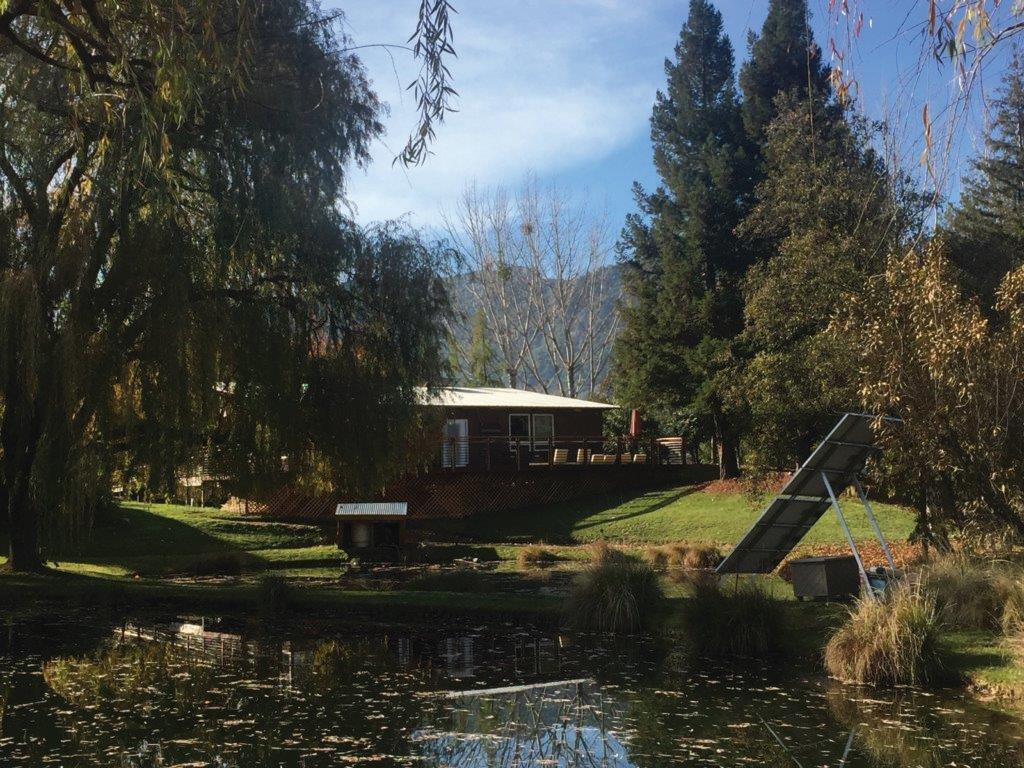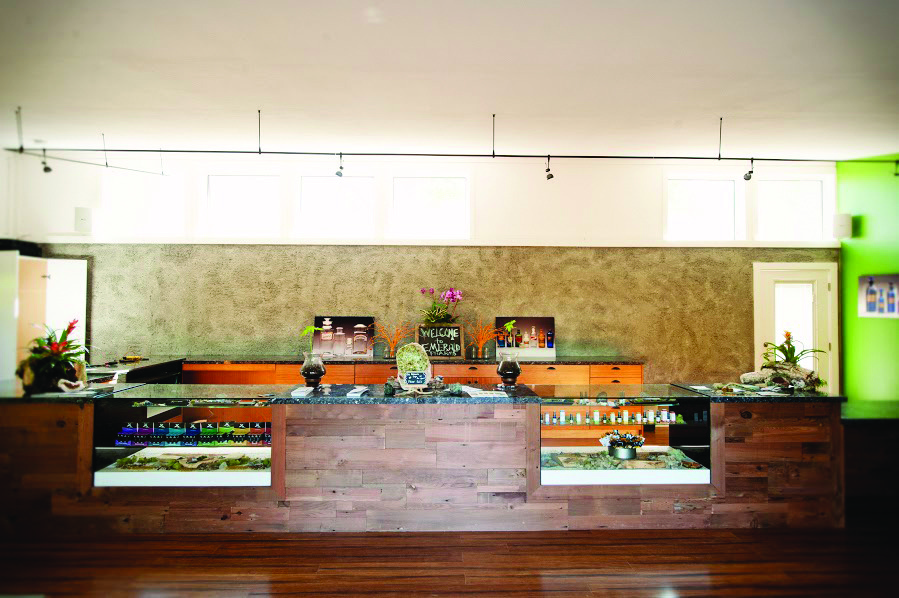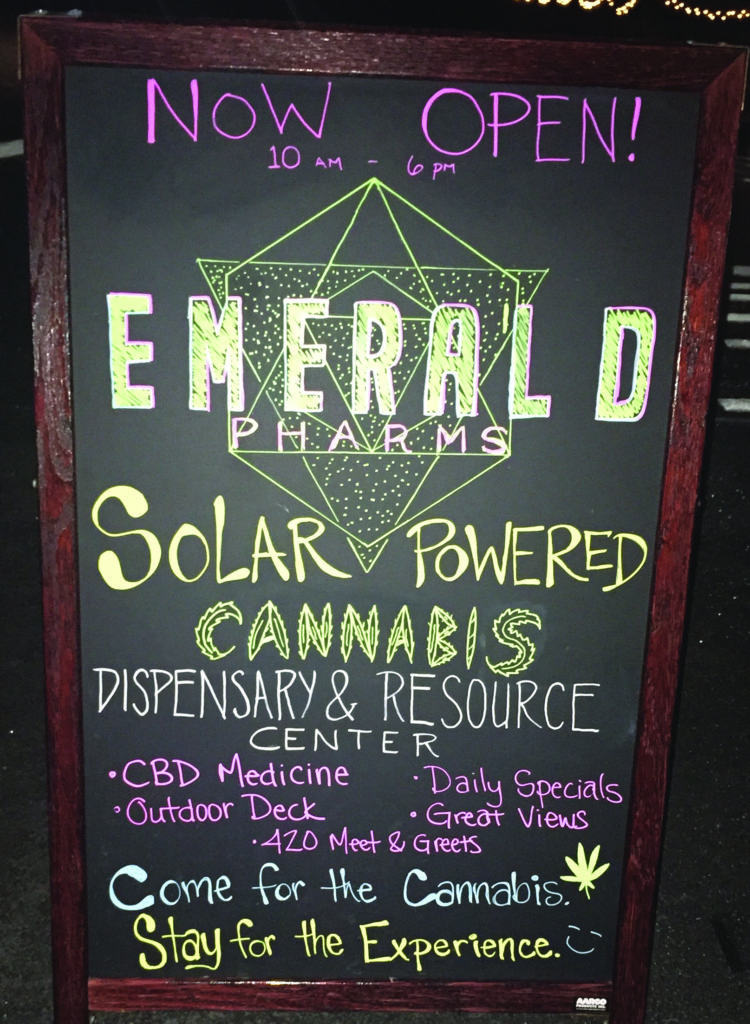
By Patrick Wagner
In the hills of Mendocino County, before the region became known as the Emerald Triangle, cannabis farmers helped pioneer the solar power industry through their need for off-the-grid living.
Now, decades later, alternative energy and cannabis remain intertwined in Northern California, where Emerald Pharms became the world’s first solar-powered medical marijuana dispensary when it opened last year.
The 1,200-square-foot dispensary sits in the heart of John Schaeffer’s Solar Living Center, a three-tiered, solar-powered complex dedicated to promoting and supplying sustainable lifestyles. The 12-acre property in Hopland houses educational exhibits, Emerald Pharms and the Real Goods eco-store, which originally opened in 1978 and sold the first photovoltaic panel to a local cannabis grower, Schaeffer says.
Commercial cannabis farming and the fledgling solar industry formed a symbiotic relationship.

The Solar Living Center is “more symbolic than anything,” Schaeffer says.
“It’s showing that you’re cutting-edge in terms of fossil fuel footprint because we’re 100% powered by the sun,” he says. “You’re not using fossil fuel to keep people off the grid. Cannabis growers are the ones who pioneered the whole economy in the Emerald Triangle, so they’re tied in symbolically with each other.”
Emerald Pharms is somewhat of an homage to Real Goods’ early patrons, but it serves as a proof of concept for the marriage between green energy and alternative medicine. Schaeffer sought out Martin Lee as a consultant for the project, because of Lee’s ongoing work as the director of Project CBD, a California-based nonprofit dedicated to the medical attributes of cannabis. Lee, who has also authored books charting the history of both marijuana and LSD, saw the value of the project immediately.
Lee says Schaeffer “wanted a dispensary that had a serious medical aspect to it.”
Schaeffer says building a solar-powered dispensary would normally cost at least $25,000 more than a traditionally-powered facility. But since Emerald Pharms was built as an addition to his complex, the real costs were more a matter of navigating California gray-area medical marijuana laws.
“As prohibition is going away, and now that the regulations are changing, there’s a lot of needle-threading to do in terms of county and state regulations,” he says. “A lot of the regulatory functions were very confusing and tricky.”
The property lies on a narrow stretch of California’s Highway 101, where traffic dwindles down to two lanes and drivers going both directions have a full view of the property. Today, the Solar Living Center draws almost 200,000 visitors each year, making it one of the largest tourist attractions between the Golden Gate Bridge and Oregon’s Crater Lake.
The dispensary does not include an on-site grow; however, Lee says there have been talks of setting up a CBD-focused greenhouse as a public 
“We just want to position ourselves in a way to reflect positively on the industry and the community,” Lee says. “We look at it like it’s a medicinal herb, just like the lavender in the children’s garden.”
Schaeffer believes Emerald Pharms will do more for the center than just add customers.
“It’s a more well-rounded offering,” he says. “Getting into the health and healing products and conscientiousness. Supporting all of our local growers in the Emerald Triangle. Teaching people how solar does meld with cannabis and sort of integrating the two disciplines together.”
Alongside the heirloom genetics and assortments of THC- and CBD-infused products, visitors have the option to explore the other compound attractions that Schaeffer has been building since 1994.
The center has a variety of art sculptures lining the shores of its ponds, where walkways take visitors through the various gardens and attractions. The center features a bamboo pyramid, solar calendar, hoops tipi, workshop yurt, camping area and a series of five classic hot-rods staked into place by the trees growing up through the steel frames.
“Last December we put in an observation bee hive and we put in a pollinator garden for food for the bees,” Schaeffer says. “We’ve also put in a lavender labyrinth.”
The scope of the project has been expanding ever since Schaeffer came to the area in 1971. Since then, Schaeffer has opened two other Real Goods locations. He launched the first ever “Off-the-Grid Day” where U.S. residents are encouraged to shut off all power for two hours to better understand their dependency on the utility grid. Schaeffer was even invited to the White House by President Bill Clinton to help in the “Greening of the White House.”
After selling that first solar panel in 1978, Schaeffer saw that his customers were actually refugee hippies from across the country who settled into the Mendocino hillsides for quiet lives as cannabis farmers.
“They were part of the early solar movement,” he says. “We’d have executives from ARCO Solar coming up in business suits trying to figure out why this tiny little country store in the hills of Mendocino County was selling hundreds of thousands of solar panels, only to discover it was because the cannabis growers were the only ones who could afford the panels and they couldn’t live off-grid out in the hills without the support of solar.”



